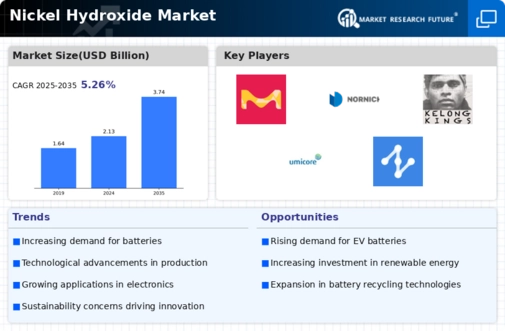Market Trends
Key Emerging Trends in the Nickel Hydroxide Market
The decline in the demand for vehicles reliant on fossil fuels is a global trend, primarily fueled by an increased awareness of environmental pollution among the population. This shift has led to a surge in the popularity of eco-friendly vehicles, particularly in developed nations. Electric vehicles (EVs) are at the forefront of this transformation, as they offer a cleaner alternative by producing no emissions and reducing dependence on fossil fuels.
One of the key components driving the adoption of electric vehicles is the rising demand for nickel hydroxide batteries. These batteries boast several advantages, including a 30-40% higher capacity compared to standard nickel-cadmium (Ni-Cd) batteries. Additionally, they are known for their easy storage and transportation, environmental friendliness, and recyclability. Nickel is a crucial component in the production of various types of batteries, such as Ni-Cd, Fe-Ni, Ni-Zn, and Ni-H2. Notably, nickel-metal batteries have a significantly longer life cycle than lead-acid batteries and are recognized for their safety and tolerance to abuse, making them a popular choice in hybrid electric vehicles (HEVs).
The push towards electric vehicles is not only a result of consumer preferences but also a response to global factors. Manufacturers are compelled to offer electric vehicles worldwide due to the increasing demand for low-emission transportation. Government support further accelerates this shift, with subsidies and tax breaks promoting long-range, zero-emission vehicles. According to the International Energy Agency (IEA), global sales of electric cars experienced a substantial increase in 2022, reaching 2 million units in the first quarter, marking a 75% growth compared to the same period in 2021. Sustained policies associated with electric vehicles play a pivotal role in this growth.
Governments around the world are actively supporting the transition to electric vehicles. In 2021 alone, incentives and subsidies for electric vehicles increased by approximately 30 billion USD. Many nations are committing to phasing out internal combustion engines or setting ambitious goals for the electrification of vehicles. For instance, China has proposed a regulation that would require all new car sales in 2035 to be hybrids or new-energy vehicles (NEVs). The plan, issued by the Society of Automotive Engineers of China (SAE-China) and the Ministry of Industry and Information Technology, envisions hybrids and NEVs, including electric, plug-in hybrid, or fuel cell-powered vehicles, accounting for half of total new sales in 15 years.
Despite challenges, such as the impact of the COVID-19 pandemic, the sales of new energy vehicles (NEVs) are expected to rebound. Projections indicate a 20% recovery by 2025 and a more significant 40% rebound by 2030. These forecasts signal a resilient and promising future for the electric vehicle market, underscoring the ongoing commitment to sustainable and environmentally friendly transportation solutions.








Leave a Comment